Corporate Law Report: Shareholder Rights and Contractual Obligations
VerifiedAdded on 2021/09/14
|10
|2979
|180
Report
AI Summary
This report analyzes several key aspects of corporate law through a series of legal questions. The first question examines the rights of a shareholder, Bob, and whether he can take legal action against directors Sam and Kate for actions that include issuing dividends, using profits for personal gain, and diverting business opportunities. It explores the statutory derivative action and oppressive conduct remedies. The second question addresses the validity of a contract entered into by Snow Ltd, focusing on the authority of the individuals signing the contract and the application of the indoor management rule. The final question investigates the legal liabilities of Apex Ltd and its directors related to issuing a prospectus, examining disclosure requirements and the consequences of defective disclosures, including misleading statements and omissions of material information. The analysis is supported by relevant case law and statutory provisions from the Corporations Act 2001.
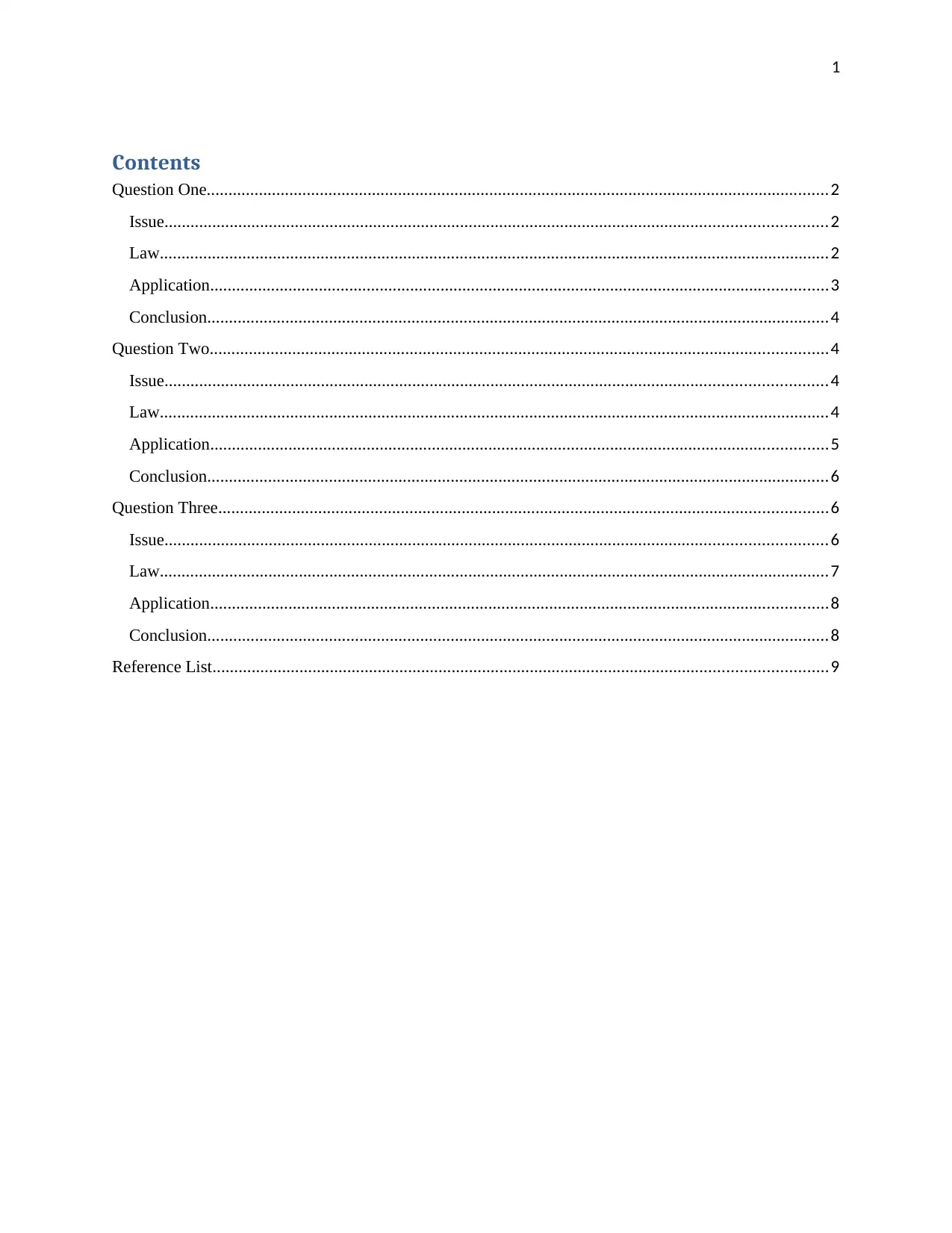
1
Contents
Question One...............................................................................................................................................2
Issue........................................................................................................................................................2
Law..........................................................................................................................................................2
Application..............................................................................................................................................3
Conclusion...............................................................................................................................................4
Question Two..............................................................................................................................................4
Issue........................................................................................................................................................4
Law..........................................................................................................................................................4
Application..............................................................................................................................................5
Conclusion...............................................................................................................................................6
Question Three............................................................................................................................................6
Issue........................................................................................................................................................6
Law..........................................................................................................................................................7
Application..............................................................................................................................................8
Conclusion...............................................................................................................................................8
Reference List.............................................................................................................................................9
Contents
Question One...............................................................................................................................................2
Issue........................................................................................................................................................2
Law..........................................................................................................................................................2
Application..............................................................................................................................................3
Conclusion...............................................................................................................................................4
Question Two..............................................................................................................................................4
Issue........................................................................................................................................................4
Law..........................................................................................................................................................4
Application..............................................................................................................................................5
Conclusion...............................................................................................................................................6
Question Three............................................................................................................................................6
Issue........................................................................................................................................................6
Law..........................................................................................................................................................7
Application..............................................................................................................................................8
Conclusion...............................................................................................................................................8
Reference List.............................................................................................................................................9
Paraphrase This Document
Need a fresh take? Get an instant paraphrase of this document with our AI Paraphraser

2
Question One
Issue
Can Bob take legal action against Sam and Kate for their actions?
Law
A company upon incorporation acquires the status of a mock legal person. Every company is
governed by its officers as it does not have a mind of its own. The directors are the prime officers
who are assigned with the tasks of undertakings acts of the company. The tasks of the directors
includes that their actions must not harm the members of the company.
The statutory derivative action (SDA) is the remedy that is available under which if any
wrongful act is conducted, then, it is the company that has the power to bring action against the
wrongdoer and is held in Foss v Harbottle (1843). (Boyle 2002)
However, the rule is considered to be harsh when no action is undertaken by the company. In
such situation, there are few exceptions under which an individual member is permitted to bring
action against the wrongdoers and is held in Swansson v RA Pratt Properties Pty Ltd (2002).
This action is imbibed under section 236 of the Corporation Act 2001, wherein any
member/former member or any officers is empowered to bring action in the name of the
company by seeking leave of the court under section 236(1)(b). The exceptions include: (Chew
2017)
i. When the ratification is inadequate;
ii. The transaction taken by the company is ultra virus;
iii. The shareholders personal right is violated;
iv. A fraud is incurred on the minority;
v. In the interest of justice;
vi. When there are chances that the company will not initiate action.
vii. The application is bought by the member in good faith.
As per section 241 of the Act, the court has the power to take actions and gave orders it deem fit.
Costs orders can also be imposed under section 242 of the Act.
Apart from the above remedy the aggrieved member also has the right to sue for statutory
oppression remedy. The court under section 233 of the Act can make orders if the oppression is
established by the member. As per section 232 of the Act, an order can be made of the conduct
Question One
Issue
Can Bob take legal action against Sam and Kate for their actions?
Law
A company upon incorporation acquires the status of a mock legal person. Every company is
governed by its officers as it does not have a mind of its own. The directors are the prime officers
who are assigned with the tasks of undertakings acts of the company. The tasks of the directors
includes that their actions must not harm the members of the company.
The statutory derivative action (SDA) is the remedy that is available under which if any
wrongful act is conducted, then, it is the company that has the power to bring action against the
wrongdoer and is held in Foss v Harbottle (1843). (Boyle 2002)
However, the rule is considered to be harsh when no action is undertaken by the company. In
such situation, there are few exceptions under which an individual member is permitted to bring
action against the wrongdoers and is held in Swansson v RA Pratt Properties Pty Ltd (2002).
This action is imbibed under section 236 of the Corporation Act 2001, wherein any
member/former member or any officers is empowered to bring action in the name of the
company by seeking leave of the court under section 236(1)(b). The exceptions include: (Chew
2017)
i. When the ratification is inadequate;
ii. The transaction taken by the company is ultra virus;
iii. The shareholders personal right is violated;
iv. A fraud is incurred on the minority;
v. In the interest of justice;
vi. When there are chances that the company will not initiate action.
vii. The application is bought by the member in good faith.
As per section 241 of the Act, the court has the power to take actions and gave orders it deem fit.
Costs orders can also be imposed under section 242 of the Act.
Apart from the above remedy the aggrieved member also has the right to sue for statutory
oppression remedy. The court under section 233 of the Act can make orders if the oppression is
established by the member. As per section 232 of the Act, an order can be made of the conduct
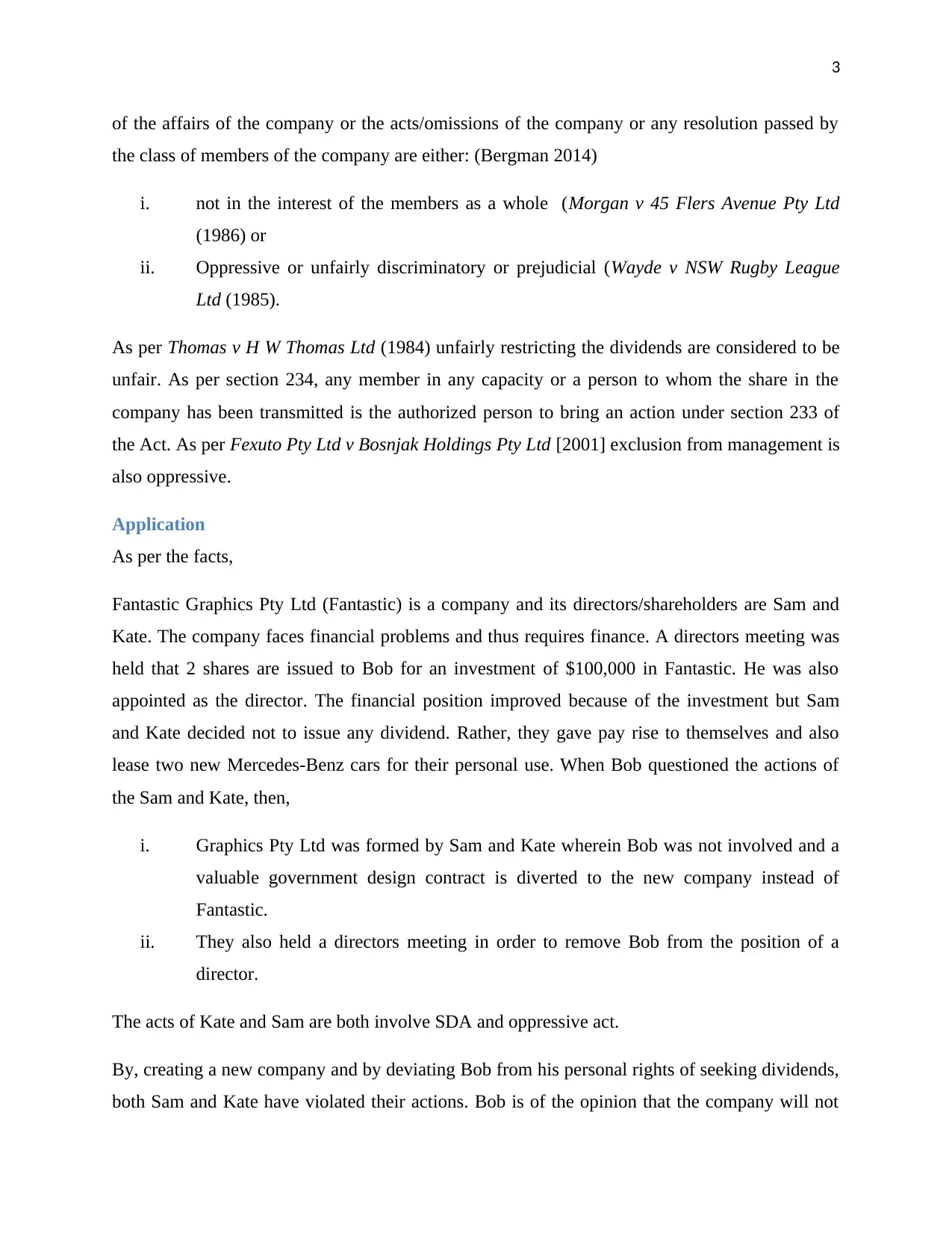
3
of the affairs of the company or the acts/omissions of the company or any resolution passed by
the class of members of the company are either: (Bergman 2014)
i. not in the interest of the members as a whole (Morgan v 45 Flers Avenue Pty Ltd
(1986) or
ii. Oppressive or unfairly discriminatory or prejudicial (Wayde v NSW Rugby League
Ltd (1985).
As per Thomas v H W Thomas Ltd (1984) unfairly restricting the dividends are considered to be
unfair. As per section 234, any member in any capacity or a person to whom the share in the
company has been transmitted is the authorized person to bring an action under section 233 of
the Act. As per Fexuto Pty Ltd v Bosnjak Holdings Pty Ltd [2001] exclusion from management is
also oppressive.
Application
As per the facts,
Fantastic Graphics Pty Ltd (Fantastic) is a company and its directors/shareholders are Sam and
Kate. The company faces financial problems and thus requires finance. A directors meeting was
held that 2 shares are issued to Bob for an investment of $100,000 in Fantastic. He was also
appointed as the director. The financial position improved because of the investment but Sam
and Kate decided not to issue any dividend. Rather, they gave pay rise to themselves and also
lease two new Mercedes-Benz cars for their personal use. When Bob questioned the actions of
the Sam and Kate, then,
i. Graphics Pty Ltd was formed by Sam and Kate wherein Bob was not involved and a
valuable government design contract is diverted to the new company instead of
Fantastic.
ii. They also held a directors meeting in order to remove Bob from the position of a
director.
The acts of Kate and Sam are both involve SDA and oppressive act.
By, creating a new company and by deviating Bob from his personal rights of seeking dividends,
both Sam and Kate have violated their actions. Bob is of the opinion that the company will not
of the affairs of the company or the acts/omissions of the company or any resolution passed by
the class of members of the company are either: (Bergman 2014)
i. not in the interest of the members as a whole (Morgan v 45 Flers Avenue Pty Ltd
(1986) or
ii. Oppressive or unfairly discriminatory or prejudicial (Wayde v NSW Rugby League
Ltd (1985).
As per Thomas v H W Thomas Ltd (1984) unfairly restricting the dividends are considered to be
unfair. As per section 234, any member in any capacity or a person to whom the share in the
company has been transmitted is the authorized person to bring an action under section 233 of
the Act. As per Fexuto Pty Ltd v Bosnjak Holdings Pty Ltd [2001] exclusion from management is
also oppressive.
Application
As per the facts,
Fantastic Graphics Pty Ltd (Fantastic) is a company and its directors/shareholders are Sam and
Kate. The company faces financial problems and thus requires finance. A directors meeting was
held that 2 shares are issued to Bob for an investment of $100,000 in Fantastic. He was also
appointed as the director. The financial position improved because of the investment but Sam
and Kate decided not to issue any dividend. Rather, they gave pay rise to themselves and also
lease two new Mercedes-Benz cars for their personal use. When Bob questioned the actions of
the Sam and Kate, then,
i. Graphics Pty Ltd was formed by Sam and Kate wherein Bob was not involved and a
valuable government design contract is diverted to the new company instead of
Fantastic.
ii. They also held a directors meeting in order to remove Bob from the position of a
director.
The acts of Kate and Sam are both involve SDA and oppressive act.
By, creating a new company and by deviating Bob from his personal rights of seeking dividends,
both Sam and Kate have violated their actions. Bob is of the opinion that the company will not
⊘ This is a preview!⊘
Do you want full access?
Subscribe today to unlock all pages.

Trusted by 1+ million students worldwide

4
bring action against them as Sam and Kate are themselves the only director/shareholder. Thus, it
is justified to bring SDA against them.
Bob can also sue Kate and Sam for oppression as by not issuing dividend, using profit for
personal use and establishing company and thus diverging the profitable business to the new
company are the acts that are unfair to Bob. Bob being the mender of the company can bring
direct oppressive action against Sam and Kate.
Conclusion
Bob can bring SDA and oppressive remedy against Kate and Sam.
Question Two
Issue
Is Snow Ltd legally bound by this contract?
Law
As per Salomon v Salomon (1897), once a company is registered it is an artificial person. As per
section 124-127 of the Act, the company is capable to enter into contract in its own name. But,
since the company is artificial thus the directors are the governing personnel’s who are take
actions on behalf of the company. Section 9 submits that the people who perform the acts of the
director are called directors. Thus, it is the acts of the persons that make him a director. So, de
facto and shadow directors are also considered as the directors . (Latimer 2012)
The Managing Director is capable to run the day to day activities of the business and it bind the
company (Entwells Pty Ltd v National and General Insurance Co Ltd (1991). As per Re
Tummon Investments Pty Ltd (1993) the authority is limited to the natural course of business.
The company has the power to execute contracts with outsiders in two forms:
i. Section 127 – By the company itself either with common seal ort without common
seal.
a. Without common seal –the document must be signed by either 2 directors OR 1
director and 1 company secretary OR sole director/company secretary
b. With common seal – witnessed by 2 directors or 1 director and 1 company
secretary;
bring action against them as Sam and Kate are themselves the only director/shareholder. Thus, it
is justified to bring SDA against them.
Bob can also sue Kate and Sam for oppression as by not issuing dividend, using profit for
personal use and establishing company and thus diverging the profitable business to the new
company are the acts that are unfair to Bob. Bob being the mender of the company can bring
direct oppressive action against Sam and Kate.
Conclusion
Bob can bring SDA and oppressive remedy against Kate and Sam.
Question Two
Issue
Is Snow Ltd legally bound by this contract?
Law
As per Salomon v Salomon (1897), once a company is registered it is an artificial person. As per
section 124-127 of the Act, the company is capable to enter into contract in its own name. But,
since the company is artificial thus the directors are the governing personnel’s who are take
actions on behalf of the company. Section 9 submits that the people who perform the acts of the
director are called directors. Thus, it is the acts of the persons that make him a director. So, de
facto and shadow directors are also considered as the directors . (Latimer 2012)
The Managing Director is capable to run the day to day activities of the business and it bind the
company (Entwells Pty Ltd v National and General Insurance Co Ltd (1991). As per Re
Tummon Investments Pty Ltd (1993) the authority is limited to the natural course of business.
The company has the power to execute contracts with outsiders in two forms:
i. Section 127 – By the company itself either with common seal ort without common
seal.
a. Without common seal –the document must be signed by either 2 directors OR 1
director and 1 company secretary OR sole director/company secretary
b. With common seal – witnessed by 2 directors or 1 director and 1 company
secretary;
Paraphrase This Document
Need a fresh take? Get an instant paraphrase of this document with our AI Paraphraser
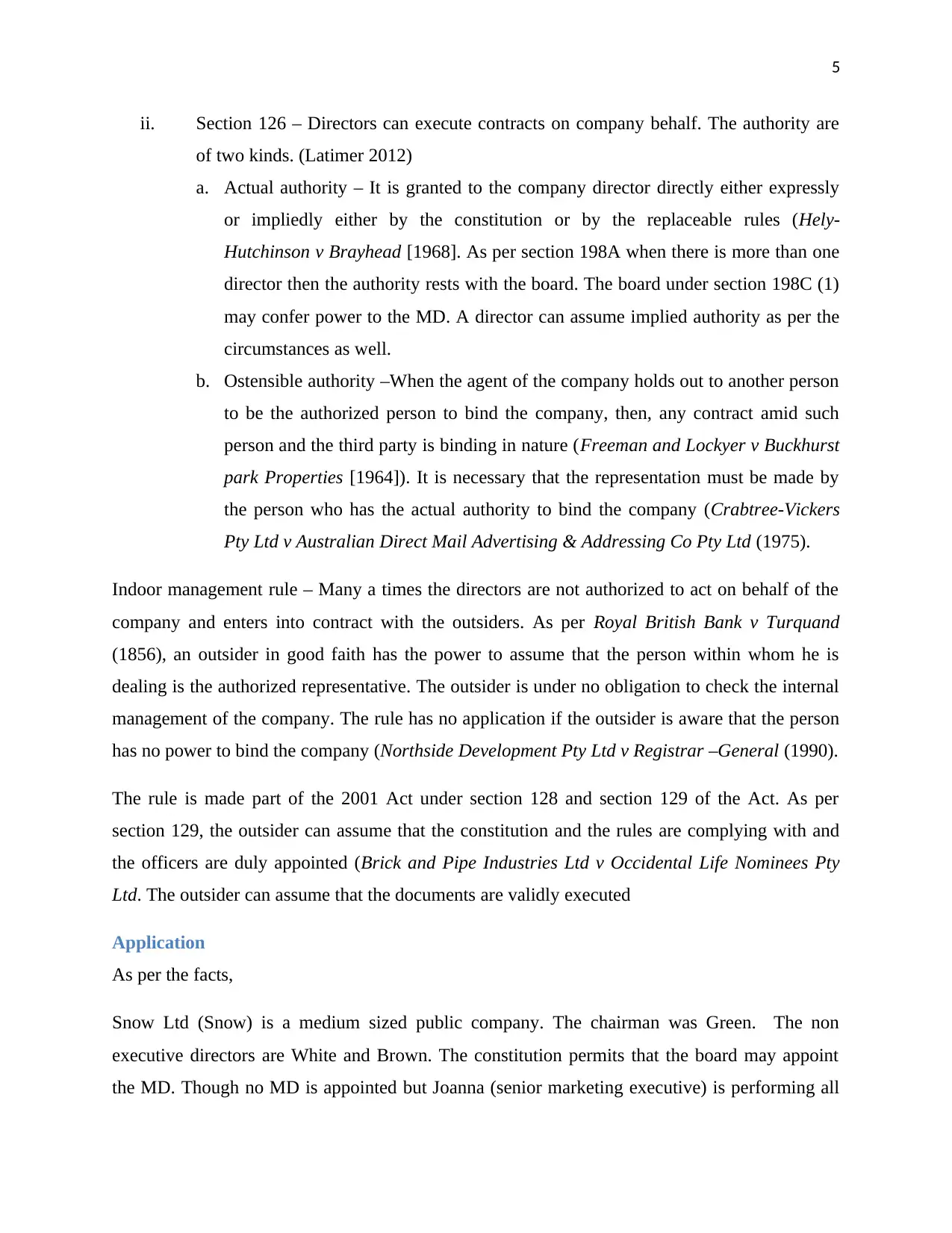
5
ii. Section 126 – Directors can execute contracts on company behalf. The authority are
of two kinds. (Latimer 2012)
a. Actual authority – It is granted to the company director directly either expressly
or impliedly either by the constitution or by the replaceable rules (Hely-
Hutchinson v Brayhead [1968]. As per section 198A when there is more than one
director then the authority rests with the board. The board under section 198C (1)
may confer power to the MD. A director can assume implied authority as per the
circumstances as well.
b. Ostensible authority –When the agent of the company holds out to another person
to be the authorized person to bind the company, then, any contract amid such
person and the third party is binding in nature (Freeman and Lockyer v Buckhurst
park Properties [1964]). It is necessary that the representation must be made by
the person who has the actual authority to bind the company (Crabtree-Vickers
Pty Ltd v Australian Direct Mail Advertising & Addressing Co Pty Ltd (1975).
Indoor management rule – Many a times the directors are not authorized to act on behalf of the
company and enters into contract with the outsiders. As per Royal British Bank v Turquand
(1856), an outsider in good faith has the power to assume that the person within whom he is
dealing is the authorized representative. The outsider is under no obligation to check the internal
management of the company. The rule has no application if the outsider is aware that the person
has no power to bind the company (Northside Development Pty Ltd v Registrar –General (1990).
The rule is made part of the 2001 Act under section 128 and section 129 of the Act. As per
section 129, the outsider can assume that the constitution and the rules are complying with and
the officers are duly appointed (Brick and Pipe Industries Ltd v Occidental Life Nominees Pty
Ltd. The outsider can assume that the documents are validly executed
Application
As per the facts,
Snow Ltd (Snow) is a medium sized public company. The chairman was Green. The non
executive directors are White and Brown. The constitution permits that the board may appoint
the MD. Though no MD is appointed but Joanna (senior marketing executive) is performing all
ii. Section 126 – Directors can execute contracts on company behalf. The authority are
of two kinds. (Latimer 2012)
a. Actual authority – It is granted to the company director directly either expressly
or impliedly either by the constitution or by the replaceable rules (Hely-
Hutchinson v Brayhead [1968]. As per section 198A when there is more than one
director then the authority rests with the board. The board under section 198C (1)
may confer power to the MD. A director can assume implied authority as per the
circumstances as well.
b. Ostensible authority –When the agent of the company holds out to another person
to be the authorized person to bind the company, then, any contract amid such
person and the third party is binding in nature (Freeman and Lockyer v Buckhurst
park Properties [1964]). It is necessary that the representation must be made by
the person who has the actual authority to bind the company (Crabtree-Vickers
Pty Ltd v Australian Direct Mail Advertising & Addressing Co Pty Ltd (1975).
Indoor management rule – Many a times the directors are not authorized to act on behalf of the
company and enters into contract with the outsiders. As per Royal British Bank v Turquand
(1856), an outsider in good faith has the power to assume that the person within whom he is
dealing is the authorized representative. The outsider is under no obligation to check the internal
management of the company. The rule has no application if the outsider is aware that the person
has no power to bind the company (Northside Development Pty Ltd v Registrar –General (1990).
The rule is made part of the 2001 Act under section 128 and section 129 of the Act. As per
section 129, the outsider can assume that the constitution and the rules are complying with and
the officers are duly appointed (Brick and Pipe Industries Ltd v Occidental Life Nominees Pty
Ltd. The outsider can assume that the documents are validly executed
Application
As per the facts,
Snow Ltd (Snow) is a medium sized public company. The chairman was Green. The non
executive directors are White and Brown. The constitution permits that the board may appoint
the MD. Though no MD is appointed but Joanna (senior marketing executive) is performing all
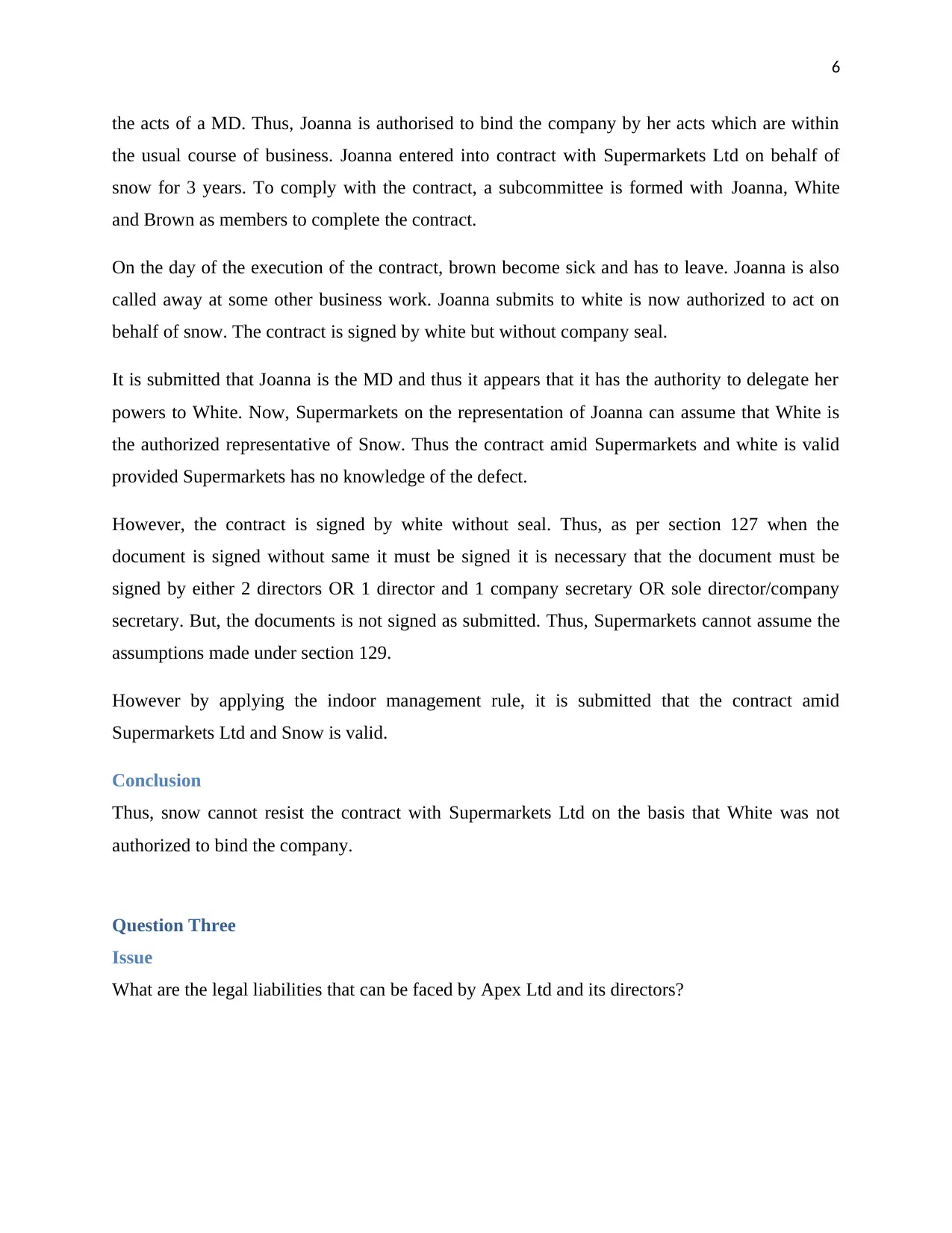
6
the acts of a MD. Thus, Joanna is authorised to bind the company by her acts which are within
the usual course of business. Joanna entered into contract with Supermarkets Ltd on behalf of
snow for 3 years. To comply with the contract, a subcommittee is formed with Joanna, White
and Brown as members to complete the contract.
On the day of the execution of the contract, brown become sick and has to leave. Joanna is also
called away at some other business work. Joanna submits to white is now authorized to act on
behalf of snow. The contract is signed by white but without company seal.
It is submitted that Joanna is the MD and thus it appears that it has the authority to delegate her
powers to White. Now, Supermarkets on the representation of Joanna can assume that White is
the authorized representative of Snow. Thus the contract amid Supermarkets and white is valid
provided Supermarkets has no knowledge of the defect.
However, the contract is signed by white without seal. Thus, as per section 127 when the
document is signed without same it must be signed it is necessary that the document must be
signed by either 2 directors OR 1 director and 1 company secretary OR sole director/company
secretary. But, the documents is not signed as submitted. Thus, Supermarkets cannot assume the
assumptions made under section 129.
However by applying the indoor management rule, it is submitted that the contract amid
Supermarkets Ltd and Snow is valid.
Conclusion
Thus, snow cannot resist the contract with Supermarkets Ltd on the basis that White was not
authorized to bind the company.
Question Three
Issue
What are the legal liabilities that can be faced by Apex Ltd and its directors?
the acts of a MD. Thus, Joanna is authorised to bind the company by her acts which are within
the usual course of business. Joanna entered into contract with Supermarkets Ltd on behalf of
snow for 3 years. To comply with the contract, a subcommittee is formed with Joanna, White
and Brown as members to complete the contract.
On the day of the execution of the contract, brown become sick and has to leave. Joanna is also
called away at some other business work. Joanna submits to white is now authorized to act on
behalf of snow. The contract is signed by white but without company seal.
It is submitted that Joanna is the MD and thus it appears that it has the authority to delegate her
powers to White. Now, Supermarkets on the representation of Joanna can assume that White is
the authorized representative of Snow. Thus the contract amid Supermarkets and white is valid
provided Supermarkets has no knowledge of the defect.
However, the contract is signed by white without seal. Thus, as per section 127 when the
document is signed without same it must be signed it is necessary that the document must be
signed by either 2 directors OR 1 director and 1 company secretary OR sole director/company
secretary. But, the documents is not signed as submitted. Thus, Supermarkets cannot assume the
assumptions made under section 129.
However by applying the indoor management rule, it is submitted that the contract amid
Supermarkets Ltd and Snow is valid.
Conclusion
Thus, snow cannot resist the contract with Supermarkets Ltd on the basis that White was not
authorized to bind the company.
Question Three
Issue
What are the legal liabilities that can be faced by Apex Ltd and its directors?
⊘ This is a preview!⊘
Do you want full access?
Subscribe today to unlock all pages.

Trusted by 1+ million students worldwide
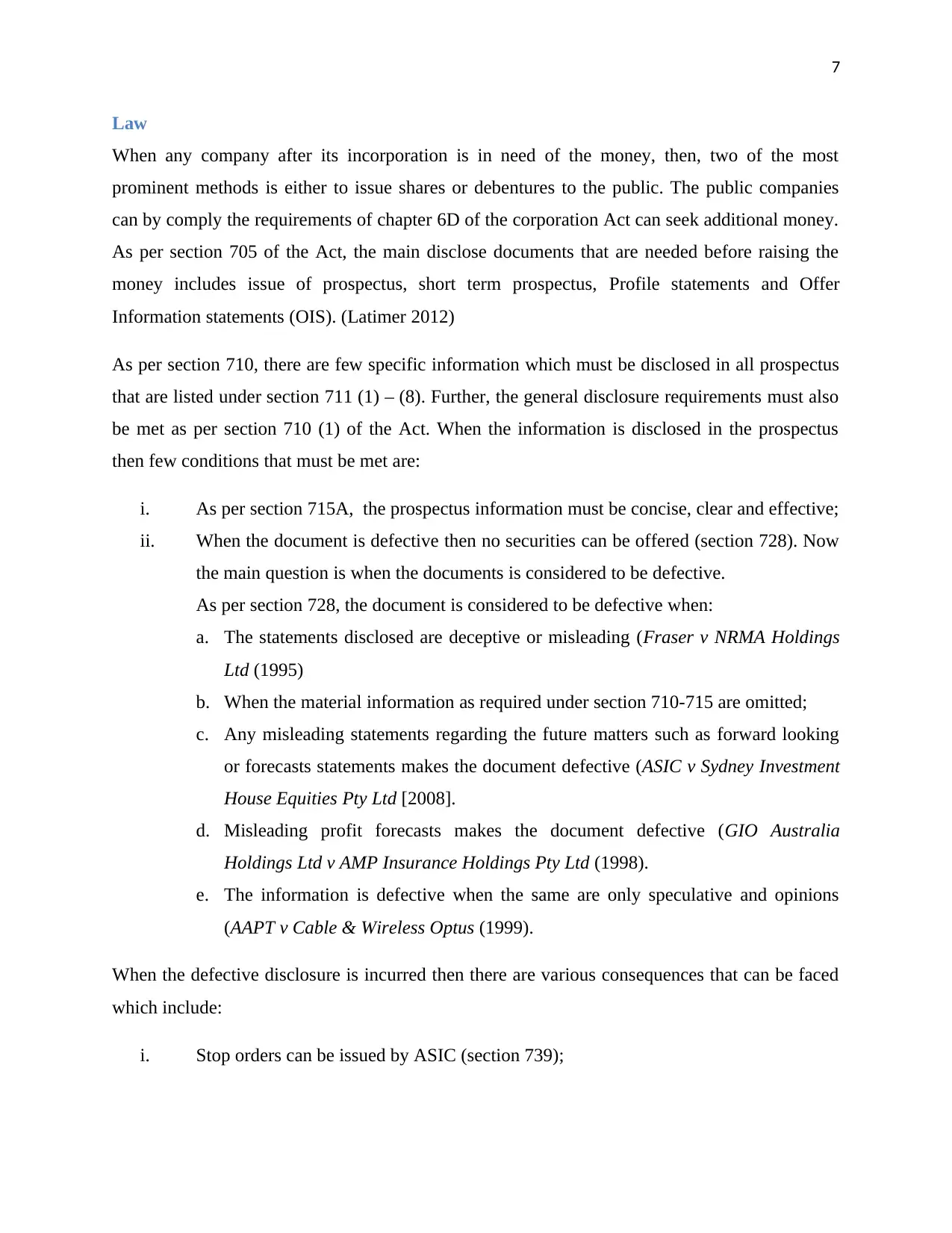
7
Law
When any company after its incorporation is in need of the money, then, two of the most
prominent methods is either to issue shares or debentures to the public. The public companies
can by comply the requirements of chapter 6D of the corporation Act can seek additional money.
As per section 705 of the Act, the main disclose documents that are needed before raising the
money includes issue of prospectus, short term prospectus, Profile statements and Offer
Information statements (OIS). (Latimer 2012)
As per section 710, there are few specific information which must be disclosed in all prospectus
that are listed under section 711 (1) – (8). Further, the general disclosure requirements must also
be met as per section 710 (1) of the Act. When the information is disclosed in the prospectus
then few conditions that must be met are:
i. As per section 715A, the prospectus information must be concise, clear and effective;
ii. When the document is defective then no securities can be offered (section 728). Now
the main question is when the documents is considered to be defective.
As per section 728, the document is considered to be defective when:
a. The statements disclosed are deceptive or misleading (Fraser v NRMA Holdings
Ltd (1995)
b. When the material information as required under section 710-715 are omitted;
c. Any misleading statements regarding the future matters such as forward looking
or forecasts statements makes the document defective (ASIC v Sydney Investment
House Equities Pty Ltd [2008].
d. Misleading profit forecasts makes the document defective (GIO Australia
Holdings Ltd v AMP Insurance Holdings Pty Ltd (1998).
e. The information is defective when the same are only speculative and opinions
(AAPT v Cable & Wireless Optus (1999).
When the defective disclosure is incurred then there are various consequences that can be faced
which include:
i. Stop orders can be issued by ASIC (section 739);
Law
When any company after its incorporation is in need of the money, then, two of the most
prominent methods is either to issue shares or debentures to the public. The public companies
can by comply the requirements of chapter 6D of the corporation Act can seek additional money.
As per section 705 of the Act, the main disclose documents that are needed before raising the
money includes issue of prospectus, short term prospectus, Profile statements and Offer
Information statements (OIS). (Latimer 2012)
As per section 710, there are few specific information which must be disclosed in all prospectus
that are listed under section 711 (1) – (8). Further, the general disclosure requirements must also
be met as per section 710 (1) of the Act. When the information is disclosed in the prospectus
then few conditions that must be met are:
i. As per section 715A, the prospectus information must be concise, clear and effective;
ii. When the document is defective then no securities can be offered (section 728). Now
the main question is when the documents is considered to be defective.
As per section 728, the document is considered to be defective when:
a. The statements disclosed are deceptive or misleading (Fraser v NRMA Holdings
Ltd (1995)
b. When the material information as required under section 710-715 are omitted;
c. Any misleading statements regarding the future matters such as forward looking
or forecasts statements makes the document defective (ASIC v Sydney Investment
House Equities Pty Ltd [2008].
d. Misleading profit forecasts makes the document defective (GIO Australia
Holdings Ltd v AMP Insurance Holdings Pty Ltd (1998).
e. The information is defective when the same are only speculative and opinions
(AAPT v Cable & Wireless Optus (1999).
When the defective disclosure is incurred then there are various consequences that can be faced
which include:
i. Stop orders can be issued by ASIC (section 739);
Paraphrase This Document
Need a fresh take? Get an instant paraphrase of this document with our AI Paraphraser
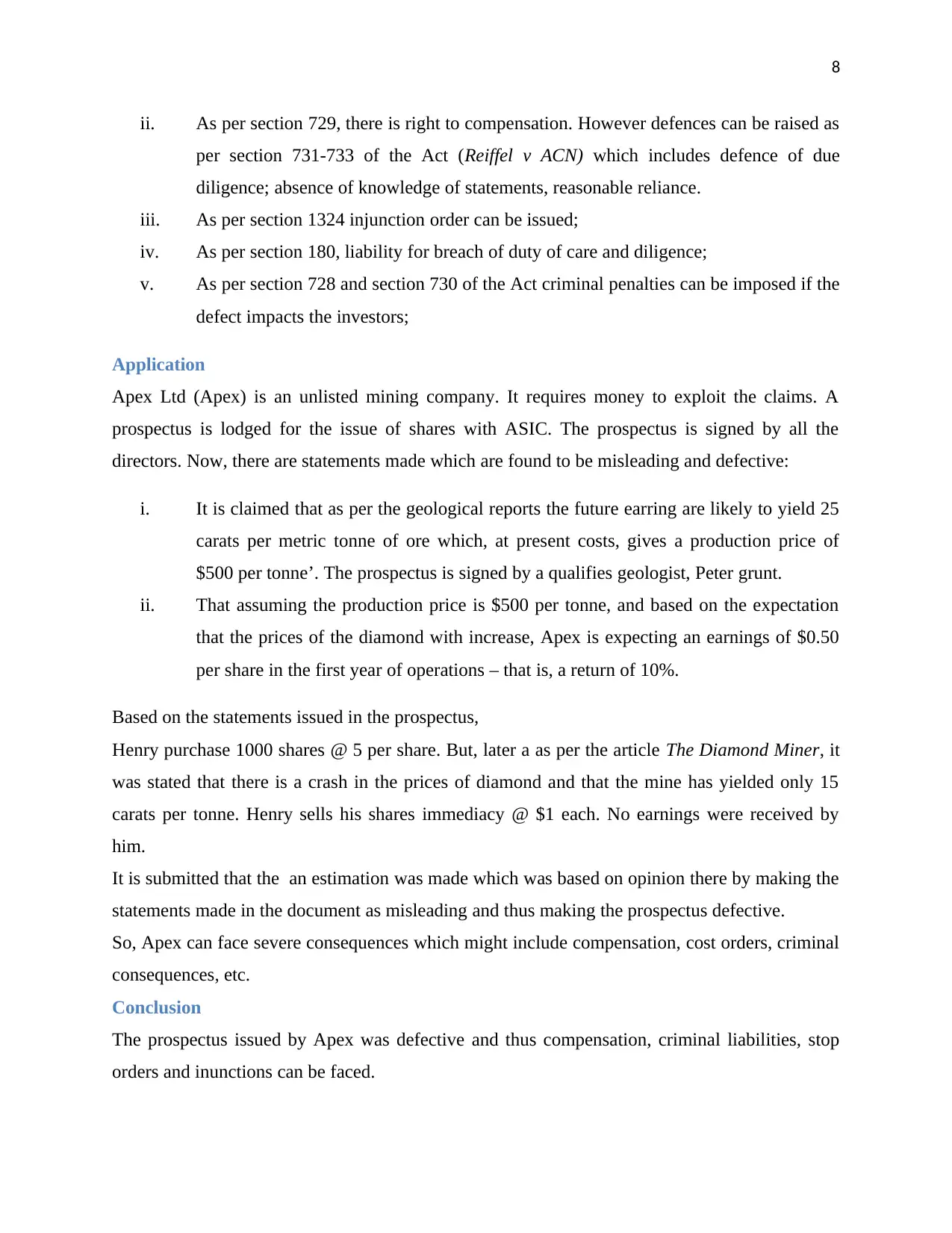
8
ii. As per section 729, there is right to compensation. However defences can be raised as
per section 731-733 of the Act (Reiffel v ACN) which includes defence of due
diligence; absence of knowledge of statements, reasonable reliance.
iii. As per section 1324 injunction order can be issued;
iv. As per section 180, liability for breach of duty of care and diligence;
v. As per section 728 and section 730 of the Act criminal penalties can be imposed if the
defect impacts the investors;
Application
Apex Ltd (Apex) is an unlisted mining company. It requires money to exploit the claims. A
prospectus is lodged for the issue of shares with ASIC. The prospectus is signed by all the
directors. Now, there are statements made which are found to be misleading and defective:
i. It is claimed that as per the geological reports the future earring are likely to yield 25
carats per metric tonne of ore which, at present costs, gives a production price of
$500 per tonne’. The prospectus is signed by a qualifies geologist, Peter grunt.
ii. That assuming the production price is $500 per tonne, and based on the expectation
that the prices of the diamond with increase, Apex is expecting an earnings of $0.50
per share in the first year of operations – that is, a return of 10%.
Based on the statements issued in the prospectus,
Henry purchase 1000 shares @ 5 per share. But, later a as per the article The Diamond Miner, it
was stated that there is a crash in the prices of diamond and that the mine has yielded only 15
carats per tonne. Henry sells his shares immediacy @ $1 each. No earnings were received by
him.
It is submitted that the an estimation was made which was based on opinion there by making the
statements made in the document as misleading and thus making the prospectus defective.
So, Apex can face severe consequences which might include compensation, cost orders, criminal
consequences, etc.
Conclusion
The prospectus issued by Apex was defective and thus compensation, criminal liabilities, stop
orders and inunctions can be faced.
ii. As per section 729, there is right to compensation. However defences can be raised as
per section 731-733 of the Act (Reiffel v ACN) which includes defence of due
diligence; absence of knowledge of statements, reasonable reliance.
iii. As per section 1324 injunction order can be issued;
iv. As per section 180, liability for breach of duty of care and diligence;
v. As per section 728 and section 730 of the Act criminal penalties can be imposed if the
defect impacts the investors;
Application
Apex Ltd (Apex) is an unlisted mining company. It requires money to exploit the claims. A
prospectus is lodged for the issue of shares with ASIC. The prospectus is signed by all the
directors. Now, there are statements made which are found to be misleading and defective:
i. It is claimed that as per the geological reports the future earring are likely to yield 25
carats per metric tonne of ore which, at present costs, gives a production price of
$500 per tonne’. The prospectus is signed by a qualifies geologist, Peter grunt.
ii. That assuming the production price is $500 per tonne, and based on the expectation
that the prices of the diamond with increase, Apex is expecting an earnings of $0.50
per share in the first year of operations – that is, a return of 10%.
Based on the statements issued in the prospectus,
Henry purchase 1000 shares @ 5 per share. But, later a as per the article The Diamond Miner, it
was stated that there is a crash in the prices of diamond and that the mine has yielded only 15
carats per tonne. Henry sells his shares immediacy @ $1 each. No earnings were received by
him.
It is submitted that the an estimation was made which was based on opinion there by making the
statements made in the document as misleading and thus making the prospectus defective.
So, Apex can face severe consequences which might include compensation, cost orders, criminal
consequences, etc.
Conclusion
The prospectus issued by Apex was defective and thus compensation, criminal liabilities, stop
orders and inunctions can be faced.
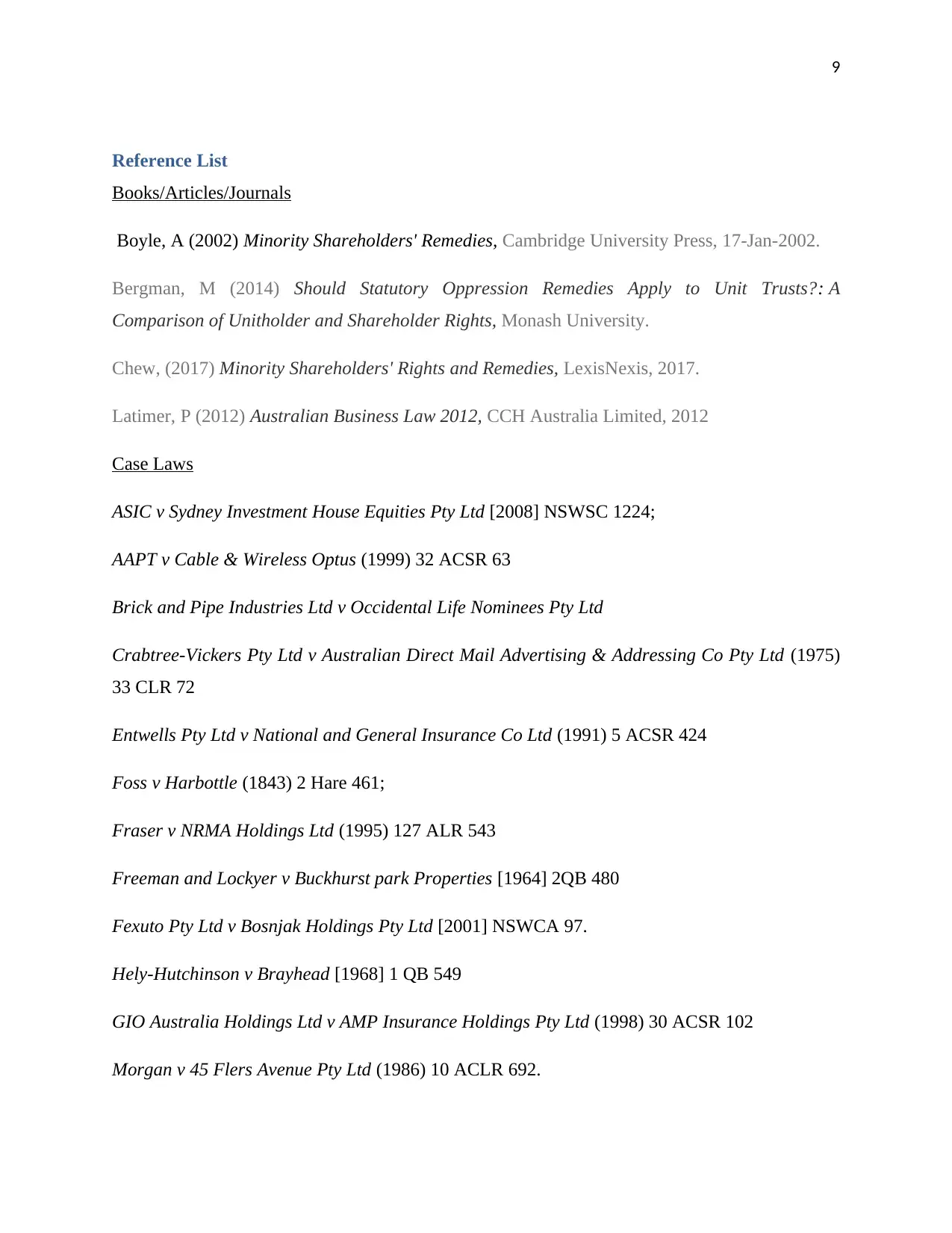
9
Reference List
Books/Articles/Journals
Boyle, A (2002) Minority Shareholders' Remedies, Cambridge University Press, 17-Jan-2002.
Bergman, M (2014) Should Statutory Oppression Remedies Apply to Unit Trusts?: A
Comparison of Unitholder and Shareholder Rights, Monash University.
Chew, (2017) Minority Shareholders' Rights and Remedies, LexisNexis, 2017.
Latimer, P (2012) Australian Business Law 2012, CCH Australia Limited, 2012
Case Laws
ASIC v Sydney Investment House Equities Pty Ltd [2008] NSWSC 1224;
AAPT v Cable & Wireless Optus (1999) 32 ACSR 63
Brick and Pipe Industries Ltd v Occidental Life Nominees Pty Ltd
Crabtree-Vickers Pty Ltd v Australian Direct Mail Advertising & Addressing Co Pty Ltd (1975)
33 CLR 72
Entwells Pty Ltd v National and General Insurance Co Ltd (1991) 5 ACSR 424
Foss v Harbottle (1843) 2 Hare 461;
Fraser v NRMA Holdings Ltd (1995) 127 ALR 543
Freeman and Lockyer v Buckhurst park Properties [1964] 2QB 480
Fexuto Pty Ltd v Bosnjak Holdings Pty Ltd [2001] NSWCA 97.
Hely-Hutchinson v Brayhead [1968] 1 QB 549
GIO Australia Holdings Ltd v AMP Insurance Holdings Pty Ltd (1998) 30 ACSR 102
Morgan v 45 Flers Avenue Pty Ltd (1986) 10 ACLR 692.
Reference List
Books/Articles/Journals
Boyle, A (2002) Minority Shareholders' Remedies, Cambridge University Press, 17-Jan-2002.
Bergman, M (2014) Should Statutory Oppression Remedies Apply to Unit Trusts?: A
Comparison of Unitholder and Shareholder Rights, Monash University.
Chew, (2017) Minority Shareholders' Rights and Remedies, LexisNexis, 2017.
Latimer, P (2012) Australian Business Law 2012, CCH Australia Limited, 2012
Case Laws
ASIC v Sydney Investment House Equities Pty Ltd [2008] NSWSC 1224;
AAPT v Cable & Wireless Optus (1999) 32 ACSR 63
Brick and Pipe Industries Ltd v Occidental Life Nominees Pty Ltd
Crabtree-Vickers Pty Ltd v Australian Direct Mail Advertising & Addressing Co Pty Ltd (1975)
33 CLR 72
Entwells Pty Ltd v National and General Insurance Co Ltd (1991) 5 ACSR 424
Foss v Harbottle (1843) 2 Hare 461;
Fraser v NRMA Holdings Ltd (1995) 127 ALR 543
Freeman and Lockyer v Buckhurst park Properties [1964] 2QB 480
Fexuto Pty Ltd v Bosnjak Holdings Pty Ltd [2001] NSWCA 97.
Hely-Hutchinson v Brayhead [1968] 1 QB 549
GIO Australia Holdings Ltd v AMP Insurance Holdings Pty Ltd (1998) 30 ACSR 102
Morgan v 45 Flers Avenue Pty Ltd (1986) 10 ACLR 692.
⊘ This is a preview!⊘
Do you want full access?
Subscribe today to unlock all pages.

Trusted by 1+ million students worldwide
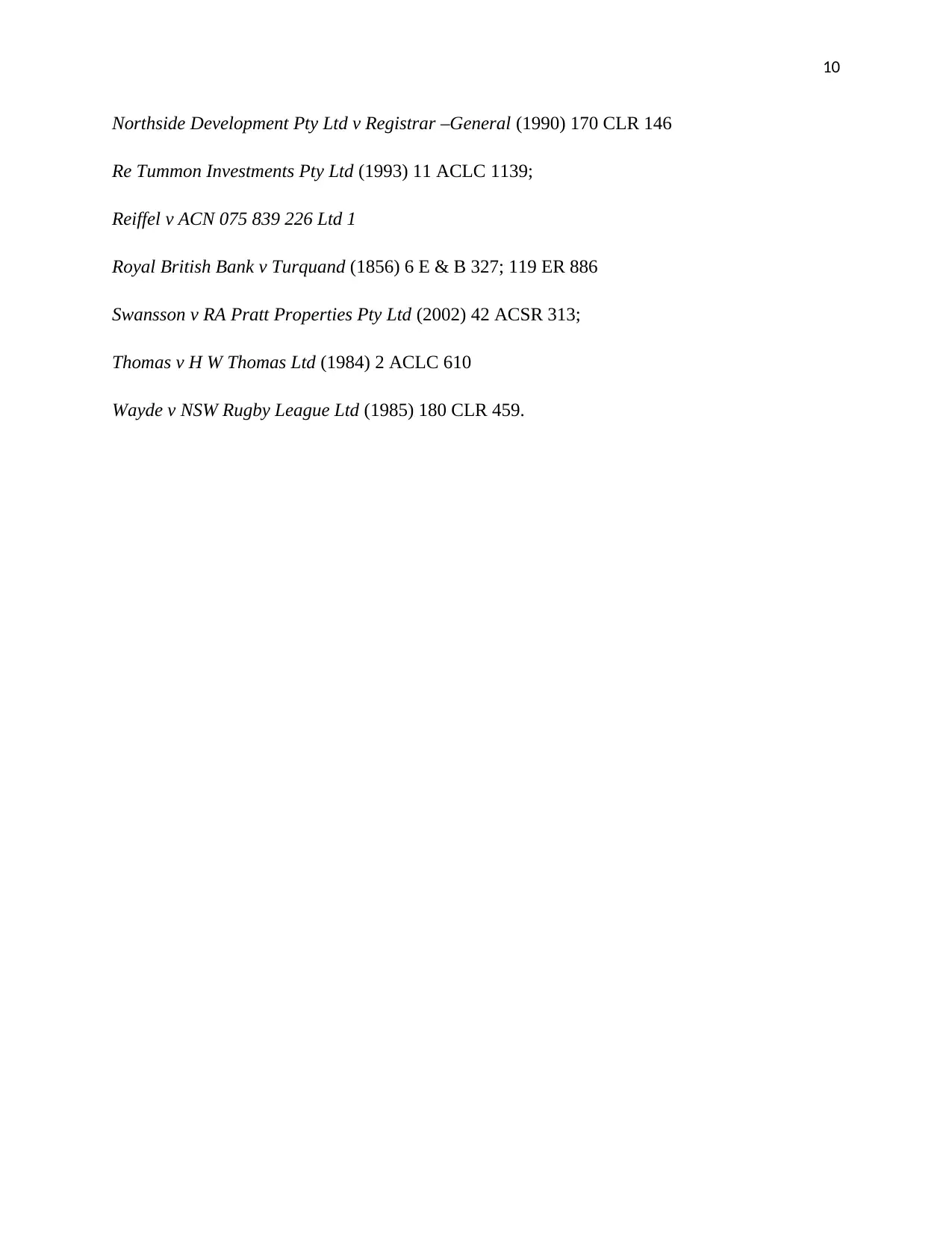
10
Northside Development Pty Ltd v Registrar –General (1990) 170 CLR 146
Re Tummon Investments Pty Ltd (1993) 11 ACLC 1139;
Reiffel v ACN 075 839 226 Ltd 1
Royal British Bank v Turquand (1856) 6 E & B 327; 119 ER 886
Swansson v RA Pratt Properties Pty Ltd (2002) 42 ACSR 313;
Thomas v H W Thomas Ltd (1984) 2 ACLC 610
Wayde v NSW Rugby League Ltd (1985) 180 CLR 459.
Northside Development Pty Ltd v Registrar –General (1990) 170 CLR 146
Re Tummon Investments Pty Ltd (1993) 11 ACLC 1139;
Reiffel v ACN 075 839 226 Ltd 1
Royal British Bank v Turquand (1856) 6 E & B 327; 119 ER 886
Swansson v RA Pratt Properties Pty Ltd (2002) 42 ACSR 313;
Thomas v H W Thomas Ltd (1984) 2 ACLC 610
Wayde v NSW Rugby League Ltd (1985) 180 CLR 459.
1 out of 10
Related Documents
Your All-in-One AI-Powered Toolkit for Academic Success.
+13062052269
info@desklib.com
Available 24*7 on WhatsApp / Email
![[object Object]](/_next/static/media/star-bottom.7253800d.svg)
Unlock your academic potential
Copyright © 2020–2025 A2Z Services. All Rights Reserved. Developed and managed by ZUCOL.




